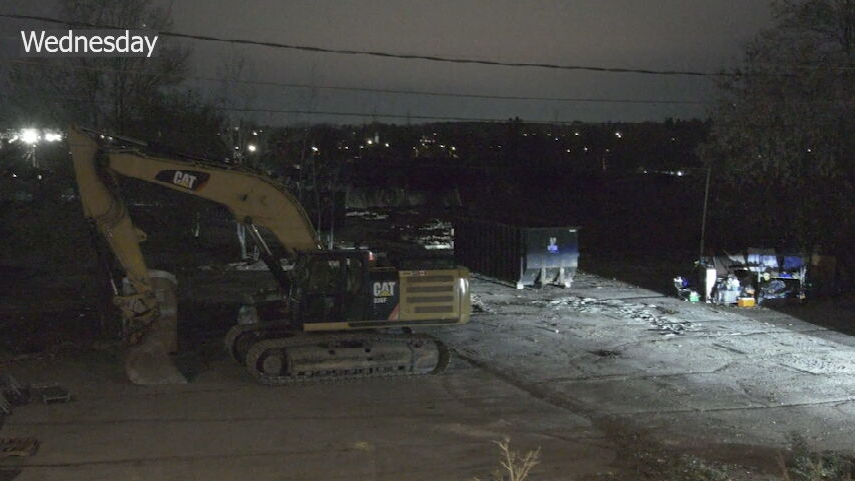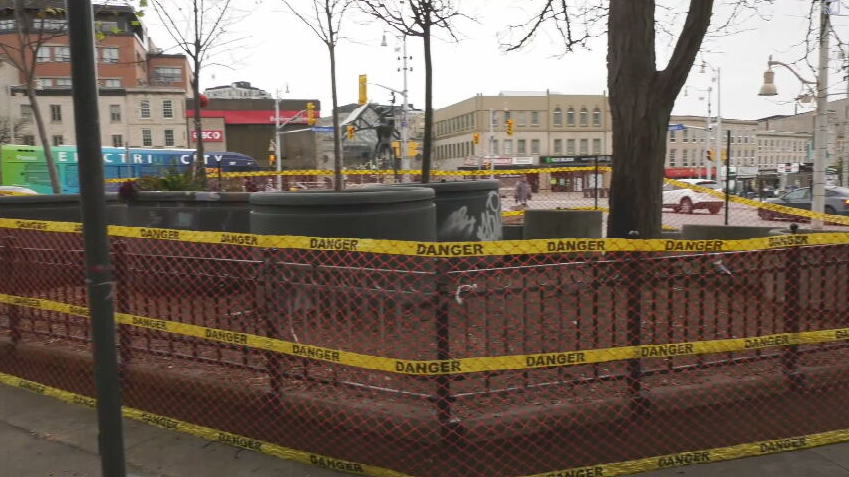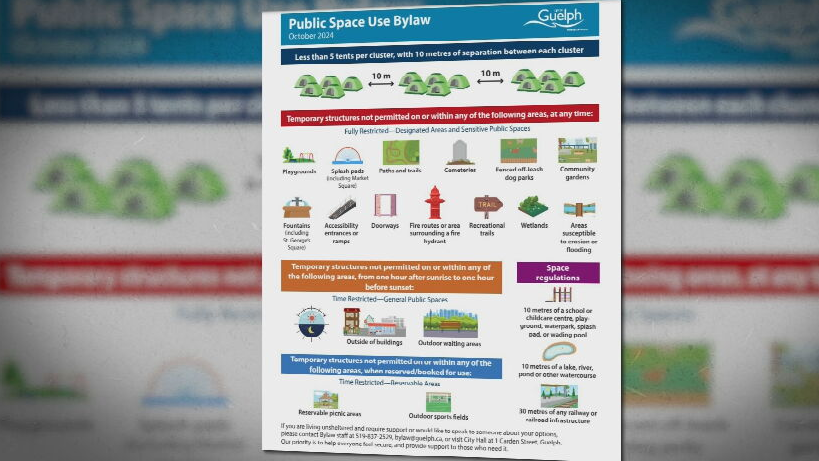Clearing encampments in Cambridge and Guelph
Some people living rough in Cambridge and Guelph have been forced to find a new place to sleep after two encampments were dismantled this week.
In the City of Cambridge, heavy machinery was brought in to help clean up the site of a former encampment.
The equipment was first spotted in at Dundas Street and Samuelson Street on Wednesday after at least four people experiencing homelessness set up an encampment in the area. By 3 p.m. that afternoon, most of the tents and structures had been removed.
On Thursday, crews could be seen picking up garbage and remaining debris in the area. The city also blocked off a portion of Dundas Street to give its workers room to manoeuvre and dismantle the encampment.
“We’re seeing the results of decades and decades of cuts to health care, cuts to education, cuts to housing and cuts to social services,” Ward 7 Councillor Scott Hamilton told CTV News. “After the pandemic, you just add all of those variables together, and this is what we get.”
The city said the encampment was removed because it was set up near railroad tracks and posed a safety risk. It was also situated on private property.
In a news release, the city said the decision was made following a series of emergency fire calls.
The owner of the property will be billed for the cleanup, but it’s not clear what happened to the people who had been living there.
The city said not all of the encampment residents accepted support when it was offered. Hamilton told CTV News he didn’t know where those people went.
“Where are they going to go? Right back on the streets again,” he guessed. “Except now they’ve lost even more hope and even more trust in the system and in those that they once believed were supposed to protect them.”
He added when heavy machinery is brought in to move people out of encampments, it erodes the public trust.
 Heavy machinery is seen at the site of a former encampment in Cambridge on Nov. 13, 2024.
Heavy machinery is seen at the site of a former encampment in Cambridge on Nov. 13, 2024.
Different city, similar story
Meanwhile, a similar scene played out in Guelph.
Residents who have been living in a downtown encampment at St. George’s Square received eviction notices in late October. By Wednesday, all of them were told they had to leave.
“There was a notice to make sure that [the encampment residents] did leave by Nov. 13, or then things would have to then be escalated. We never got to that part,” Guelph Mayor Cam Guthrie said. “[The residents] actually took up the offer of shelter, which we’re very grateful for, and they were moving into the shelter system.”
Someone who had been living at the encampment told CTV News they didn’t have much of a choice.
“There is nowhere to go,” Shane explained Wednesday. “There is no help from anyone. We are just trying to be seen by the community, just to let people know that we are still all out there – 600 people out in the bush who can’t afford this outrageous rent.”
According to the 2023 Poverty and Health Report from Wellington-Dufferin-Guelph Public Health, at least 270 people in Guelph and Wellington County were identified as experiencing homelessness during the Oct. 2021 Point-In-Time count, an initiative that aims to quantify how many people are experiencing homelessness at a given time. However, the report also stated that it was the minimum number of people who may have been homeless at the time of the count.
By Thursday, large planters stood in the spaces that had once been occupied by tents and temporary structures in St. George’s Square.
Volunteers who had been helping the encampment residents pack up said the equipment was a little too close for their comfort.
“There were situations where the machinery was pushed a little bit too forward when people were just trying to get their belongings out of the way,” volunteer Eylul Ozekes said. “There was a sense of urgency, even though the notice for the eviction was set for 3 p.m., but the movement started as early as 8 a.m.”
 Large planters are seen in Guelph where an encampment once stood. Nov. 14, 2024. (Colton Wiens/CTV News)
Large planters are seen in Guelph where an encampment once stood. Nov. 14, 2024. (Colton Wiens/CTV News)
Does anybody have a map?
Guelph released a map showing where unhoused people could set up their temporary shelters in October.
But anyone looking for the map now, won’t be able to find it on the city’s website. Instead, it has been replaced by an infographic explaining the public space use bylaw.
According to the infographic, tents may only be set up in clusters of less than five and there must be 10 metres of separation between each cluster.
Temporary structures also can’t be set up in vulnerable spaces such as playgrounds, paths and trails, cemeteries and community gardens.
 An infographic available through the City of Guelph's website is seen in this image. (Courtesy: City of Guelph)
An infographic available through the City of Guelph's website is seen in this image. (Courtesy: City of Guelph)
The mayor said he understands some people may not want to stay at an emergency shelter, but believes the bylaw and associated infographic help to provide options.
“At the same time, I’m very happy to create a downtown that is also safe and welcoming to everyone else in the public as well,” Guthrie added.
Community volunteer Mars Russell said the rules don’t truly address the city’s problem.
“They’re whack-a-moling people around. Our belief is that these folks are going to get displaced into suburban neighbourhoods on the outside and folk in the city are going to go, ‘We don’t want them there either.’”
CTVNews.ca Top Stories

Richard Perry, record producer behind 'You're So Vain' and other hits, dies at 82
Richard Perry, a hitmaking record producer with a flair for both standards and contemporary sounds whose many successes included Carly Simon’s 'You’re So Vain,' Rod Stewart’s 'The Great American Songbook' series and a Ringo Starr album featuring all four Beatles, died Tuesday. He was 82.
Hong Kong police issue arrest warrants and bounties for six activists including two Canadians
Hong Kong police on Tuesday announced a fresh round of arrest warrants for six activists based overseas, with bounties set at $1 million Hong Kong dollars for information leading to their arrests.
Read Trudeau's Christmas message
Prime Minister Justin Trudeau issued his Christmas message on Tuesday. Here is his message in full.
Stunning photos show lava erupting from Hawaii's Kilauea volcano
One of the world's most active volcanoes spewed lava into the air for a second straight day on Tuesday.
Indigenous family faced discrimination in North Bay, Ont., when they were kicked off transit bus
Ontario's Human Rights Tribunal has awarded members of an Indigenous family in North Bay $15,000 each after it ruled they were victims of discrimination.
What is flagpoling? A new ban on the practice is starting to take effect
Immigration measures announced as part of Canada's border response to president-elect Donald Trump's 25 per cent tariff threat are starting to be implemented, beginning with a ban on what's known as 'flagpoling.'
Dismiss Trump taunts, expert says after 'churlish' social media posts about Canada
U.S. president-elect Donald Trump and those in his corner continue to send out strong messages about Canada.
Heavy travel day starts with brief grounding of all American Airlines flights
American Airlines briefly grounded flights nationwide Tuesday because of a technical problem just as the Christmas travel season kicked into overdrive and winter weather threatened more potential problems for those planning to fly or drive.
King Charles III is set to focus on healthcare workers in his traditional Christmas message
King Charles III is expected to use his annual Christmas message to highlight health workers, at the end of a year in which both he and the Princess of Wales were diagnosed with cancer.

































